Ranthambhor
and Keoladeo Ghana (Bharatpur) National Park
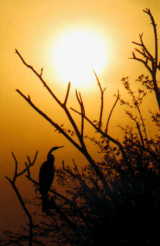 |
Northern India
20 February - 7 March 1999

by Mike Prince
|
Text-only Version
| Introduction | Daily Log
| Systematic List | Other Wildlife| Daily Totals
This trip was a combined birding
and sightseeing visit to India. The first week was entirely spent
birding, with two full days at Ranthambhor National Park and four
at Keoladeo Ghana National Park (or Bharatpur). I then met my
girlfriend in Agra for a non-birding week. This involved visiting
the Taj Mahal and other sites in Agra, the abandoned sandstone
city of Fatehpur Sikri, and Orchha, a village in Madya Pradesh
famed for its many temples. After this we attended my girlfriend's
cousins wedding, had a brief visit to Nepal, and spent several
days on the family farm just outside Lucknow.
Although birds were the main focus of the first
week I was keen to see Tigers at Ranthambhor, having missed them at Periyar
in Kerala and Royal Chitwan National Park in Nepal the previous two years. However,
it was not to be third time lucky! Sloth Bear and a brief glimpse of
a Leopard were the main mammalian recompenses. Birding was excellent
in the vicinity of Ranthambhor, including sightings of the endemic Painted
Spurfowl, as well as Indian Courser, Painted Sandgrouse, Tickell's
Blue Flycatcher and several larks and pipits. Keoladeo Ghana was a place
I had long wanted to go to, and certainly lived up to expectations. Not only
were the numbers of birds impressive but the variety, of waterbirds in particular,
was incredible. The two adult Siberian Cranes were the undoubted highlight
since the species' future looks very gloomy: last year a young bird was present
as well but unfortunately would appear not to have survived. The days of flocks
of over 100 are unlikely to ever be repeated, and it may not be long before
the extinction of the wintering birds in India. Elsewhere in the world the bulk
of the population winter in China (where BWP reports up to 2915 in 1993), with
the only other known site, in Iran, barely reaching double figures in recent
years. Other highlights of Keoladeo included the variety of raptors, especially
aquila eagles. I had seen many before, having spent 18 months in Israel, but
here they were far more a test of identification skills! Views were frequently
of perched birds, or from above in flight, and the majority of birds had to
be left unidentified. Spotted Eagle proved to be the commonest of the
aquilas, but I also managed to positively identify a few Lesser Spotted,
Steppe and Imperial Eagles. A very pale eagle caused me a few
problems; I initially thought it to be a Tawny but eventually decided it was
probably an adult fulvescens Spotted Eagle. (Note: I later queried
the identification and removed the records of Lesser Spotted Eagle, following
the split of this from Lesser Spotted as Indian Spotted Eagle, and the findings
that it is more similar to Greater Spotted than Lesser Spotted.)
My flight was booked through
Wildwings and accommodation and transport in India arranged
beforehand through Cox & Kings in Delhi. Although more
expensive, I was keen to make best use of the limited time
available in India, and using Cox & Kings proved (relatively!)
hassle-free. Beware, however, the habit of Cox & Kings
confirming bookings before actually checking with the hotels! The
day before I left for Bharatpur I received a message that my
hotel had been changed from the Bharatpur Forest Lodge to a hotel
a few miles away from the Park. Since I had specifically
requested the Forest Lodge in order to be in the Park to make
best use of my birding time, I was not best pleased! However, due
to the helpful staff at the Forest Lodge, and the fact that they
had a room available for the first two nights and then got a late
cancellation, meant that I managed to stay there after all!
In Ranthambhor I stayed at the
Hammir Resort along the road from Sawai Madhopur to the reserve.
It was a very basic (e.g. cold showers or a bucket of hot water
upon request) and not very impressive hotel arranged by Cox &
Kings, but had good birding within walking distance.
For convenience I ate in the
hotels: dinner was 100 Rs at the Hammir Resort for some good and
plentiful home cooking, whereas it cost 267 Rs at the Bharatpur
Forest Lodge for fairly ordinary food obviously tailored for a
Western taste!
The weather was excellent for
birding. Although chilly early morning and when on a jeep, it was
hot during the day but not unbearable - I generally birded
throughout the midday period.
Two books were pretty much
essential during this trip:
- Birds of the Indian
Subcontinent, Grimmett, Inskipp & Inskipp - A
refreshing change from having to use Ali & Ripley's
Pictorial Guide, although somewhat heavy!
- A Birdwatcher's Guide to
India, Kazmierczak & Singh - Includes very good site
notes for birding Ranthambhor and Keoladeo Ghana, plus
details of other nearby sites.
All birding was on my own in both
Ranthambhor and Keoladeo Ghana. Afterwards I met my girlfriend
Nisha for our tour of Agra and Orchha.
20 February
Arrived in Delhi on BA 143 from
London Heathrow at 1220 local time (having left at 2230 GMT the
previous night). I was met on arrival by a Cox & Kings
representative and given travel vouchers for the rest of my trip.
We then transferred to the domestic terminal for the Jet Airways
9W 721 flight to Jaipur (1630 - 1710). Again met by car and then
driven to Sawai Madhopur (approximately 3 hours away). Night at
Hammir Resort.
A Black-shouldered Kite
was seen at Delhi Airport, and a few Black Kites were seen
in the Delhi area. Thereafter the journey produced plenty of Common
Mynas, Little Swifts and Ring-necked Parakeets,
plus a couple of Long-tailed Shrikes and the first Indian
Peafowls of the trip.
21 February
Birding on foot along the road
from the hotel early morning, then got a lift into Sawai Madhopur
to arrange a 'gypsy' (a jeep) into Ranthambhor National Park. I
could only book for 22 February afternoon and 23 February morning
so spent the rest of the day birding on foot around Ranthambhor
Fort and back to the entrance gate. Later I discovered that I
could probably have joined a gypsy, or at least a 'canter' (an
open-topped lorry-bus) at the entrance gate.
Red-breasted Flycatchers
proved common as did Hume's Warblers, and several Large
Cuckooshrikes were seen. My first tick came with a party of
eight Large Grey Babblers in the acacia semi-desert beside
the road. Other good birds on the early morning walk included Grey
Francolin, Indian Bushlark, Bay-backed Shrike, Red
Turtle Dove, Yellow-footed Green Pigeon and Dusky
Crag Martin. Two Indian Gazelles or Chinkara
were seen on the hillside beyond the acacias. At the entrance to
the Jogi Mahal several Plum-headed Parakeets fed at very
close range, and scope views of the lake from Ranthambhor Fort
produced both species of Jacana, Cotton Teal and Painted
Stork, plus Marsh Mugger crocodile! A speciality of
the area, Brown Rock Chat, proved easy to find in the
rambling fort itself although, in the heat of the day, small
birds were not evident. A probable White-capped Bunting
did fly over, but could not be relocated. The slow walk back to
the entrance gate was very enjoyable, with Yellow-crowned
Woodpeckers, White-bellied Drongos and a Barred
Buttonquail, which ran across a dried up stream. Near the
gate itself were a Tickell's Thrush and the only Tickell's
Blue Flycatcher of the trip. Towards dusk I scanned the
cliffs for Eagle Owl and was rewarded with good views of
one bird, first seen at about 5:30pm. I then flagged a jeep down
to show them the owl, and hitch a lift back. The jeep occupants
turned out to be Michaela Strachan and a BBC film crew filming
tigers for The Really Wild Show! They were impressed by the Eagle
Owl, and I by their tales of stunning views of tigers that
afternoon!
22 February
In the morning I got a lift from
Hammir Resort to the area of semi-desert and cultivation north-west
of the road from Sawai Madhopur and was picked up at midday. This
area was very productive for desert birds. Ashy-crowned
Sparrow Larks were common, and amongst many Paddyfield
Pipits were a few Blyth's and one Tawny, all
providing quite an identification challenge. Prinias were
also difficult, although I eventually managed a singing Rufous-fronted
as well as the commoner Jungle Prinias. Both Painted
and Chestnut-bellied Sandgrouse were seen, and two Indian
Coursers were the highlight of the morning.
I had hired a gypsy into
Ranthambhor Park for the afternoon and eagerly looked forward to
the prospect of seeing tigers and other mammals. Birding was
possible from the gypsy as well, aided by the guides' knowledge
of some of the regular species. At the entrance they pointed out
a pair of roosting Collared Scops Owls. We also saw a few
of the endemic Painted Spurfowls - it had been a little
surprising that I hadn't seen any the day before since the
entrance track is generally regarded as the best spot.
Views of deer were superb from
the gypsy: it was possible to get very close to Chital (Spotted
Deer), Sambar and Nilgai (Blue Bull), and we
also saw two Chinkaras (Indian Gazelles). There were signs
of tigers, but unfortunately no sightings. The other mammals seen
were some Wild Boar and a fabulous Sloth Bear,
which approached just yards from the gypsy. Apparently there was
one tiger sighting in the afternoon, of one along the entrance
track where I was walking alone at a similar time the day before!
23 February
Another tiger attempt in the
morning, which again proved fruitless! However, as we were
stopped beside a stream I caught a glimpse of a large buff-yellow
mammal with black markings as it disappeared behind a line of
bushes. It was almost certainly a Leopard (which are seen
far less frequently than tigers). However, instead of waiting
patiently where we would have probably seen it move out of cover
again, the guide told the driver to get much closer. Thirty
seconds of bumping around in a high-speed jeep later, we had
difficult views through vegetation to the area where the leopard
had been. Undoubtedly it had heard us coming and had long gone by
then! Had it been a tiger it would probably have stayed in the
area, but unfortunately leopards are far more secretive.
We returned to Hammir Resort
where I was then taken by a Cox and Kings driver in an Ambassador
car to Bharatpur (approximately a five hour drive). After my
hassles booking in to the Forest Lodge I took a cycle rickshaw
and spent the final couple of hours birding along the main road
of Keoladeo Ghana National Park as far as Sapan Mari and then
west from there. The numbers of waterbirds were spectacular, with
a single jheel holding almost 1000 Purple Gallinules as
well as numerous herons, egrets, storks, ibis,
ducks and geese. The night was spent at Bharatpur
Forest Lodge.
24 February
I spent the early morning birding
the wooded areas of the Forest Nursery and Forest Lodge, before
taking a rickshaw to Keoladeo Temple. In the ditch along the main
road was a Yellow Bittern. At least three Spotted
Eagles were seen, plus an excellent sub-adult White-tailed
Eagle which flew low over Sapan Mari and landed in a tree. I
left the rickshaw at the temple and spent the rest of the day
birding on foot as far as Python Gate and back to the Forest
Lodge along the main roads. My main target for the day was to see
the two adult Siberian Cranes. They had apparently been
spending their time either on Mansarovar or Chakwa Chakwi. Sure
enough, I found them towards the south side of Mansarovar, where
there were large numbers of waterbirds. Walking alongside the
Ghana Canal I saw two Tickell's Thrushes, both fairly
skulking individuals. I walked back along the same route, passed
the 12 White Pelicans on Mansarovar and five Dalmation
Pelicans near the Temple. As it neared dusk I waited at a
regular spot, looking towards Nil Tal, for Dusky Eagle Owl.
At about 6:15pm, having been calling out of sight for some time,
two birds flew into a dead tree, where one remained calling.
25 February
After an early morning birding around the Forest
Nursery, I took a rickshaw and was dropped near Python Gate. I then spent the
rest of the day birding on foot via Lala Pyare Ka Kund, the brick path west
from there, Mrig Tal, Ram band and finally back to Shanti Kutir. The heat of
the day proved ideal for raptors and, amongst the many White-rumped and
occasional Long-billed Vultures, aquila eagles were quite an identification
challenge. The single sub-adult Steppe Eagle, and a second calendar year
and a sub-adult Imperial were not difficult, but Spotted and Lesser Spotted
were more of a problem. The day produced at least four Spotted in total,
with no definite Lesser Spotted. Other raptors seen included both Booted
and Bonelli's Eagles, plus Red-headed Vulture and Oriental
Honey Buzzard, and a ring-tail Montagu's or Pallid Harrier.
The dry areas of the park were good for some different species, including a
pair of Rufous-tailed Larks perching in a tree, a Rufous-tailed (Isabelline)
Shrike and a party of Large Grey Babblers. Noticeable at Mrig Tal
especially were the large numbers of Citrine Wagtails - I recorded about
100 in the day, and didn't see a single Yellow in my time at Bharatpur! Finally
an impressive Lesser Adjutant was at Mrig Tal.
26 February
Once again I birded the Forest
Nursery area in the early morning, and once again was
unsuccessful in looking for Marshall's Iora. However, an Indian
Grey Hornbill was seen in flight just outside the Nursery
entrance, and I was shown a superb roosting Large-tailed
Nightjar by some local boys, who wouldn't even accept a tip!
I then hired a cycle from the Forest Lodge and birded along the
eastern border of the park to the dry area of Koladahar. Four Ashy-crowned
Sparrow Larks were seen in a grassy area along the south-eastern
border, where I got involved with a local game of cricket! I then
went a little further, to near the southernmost point, where I
had very good views of a Sirkeer Malkoha. Here I managed
to get a puncture, and so ended up with a long walk back along
the same route!
27 February
I spent my final morning with
another fruitless attempt for Marshall's Iora in
the Forest Nursery area, then hired a cycle and birded the main
road to Python Gate and the dry area south of Mansarovar and
around Python Point. Species seen were generally similar to the
previous days. In the dry area near Python Point I saw a few Streaked
Weavers, although was a little surprised not to find any
other weavers. Birding back along the same route I saw a very
pale aquila eagle in flight, which then proceeded to land in a
tree. It looked like a light-phase Tawny Eagle
but I couldn't rule out a fulvescens variant Spotted
Eagle. In the end I decided it was most probably an
adult fulvescens Spotted, though it would have been useful to
have seen the underwing to be more sure. Luckily I managed to get
some reasonable photos.
28 February
Today was the first day of the
non-birding half of my holiday. A car picked me at the Forest
Lodge up in the morning and took me to Agra Cantt Railway Station
(1 hour from Bharatpur) where I met my girlfriend from the train
from Delhi. We checked in to the Trident Hotel and then used the
car to go sightseeing. In Agra we went to the incredible Taj
Mahal, Agra Fort and Itimad-ud-daulah. Then we went to the
abandoned sandstone city of Fatehpur Sikri, between Agra and
Bharatpur. This was also an impressive place, and had a few good
birds such as Brown Rock Chat and large numbers of Little
Swifts. We spent the night at the very comfortable
Trident Hotel.
1 March
From the Trident we took a car to
Agra Cantt Railway Station where we caught the Shatabdi Express
to Jhansi. Here we were met by another Cox and Kings car and
travelled to Orchha, with a stop to take in Jhansi Fort on the
way (where I saw Dusky Crag Martin and Brown Rock Chat).
The afternoon was spent exploring the many temples of Orchha (where
there were several more Dusky Crag Martins and Brown
Rock Chats). Overnight we stayed at the run-down yet
spectacular Hotel Sheesh Mahal.
2 March
The day was spent at Orchha,
unsuccessfully avoiding the local children armed with water
pistols containing coloured water as part of the annual Holi
celebrations! In the late afternoon we were picked up by car and
taken to Jhansi Railway Station where we caught the Sabarmati
Express overnight to Lucknow.
3 March
The day involved various
preparations for Nisha's cousins wedding (including the mehendi
ceremony where the bride's hands and feet are painted with henna).
I spent some time birding around the family farm in the afternoon.
4 March
An early morning walk around the
farm in the morning was enjoyable in that I didn't really know
what to expect; a Sirkeer Malkoha was one of the first
birds I saw, and there were good numbers of pipits
(Paddyfield, Olive-backed and Tree) in the
fields. I also saw the only Yellow Wagtails of the trip,
and an unidentified aquila eagle. During the day I visited a few
places in Lucknow (including The Residency and Bara Imambara).
The afternoon was spent preparing for the evening's wedding
ceremony.
5 March
I spent the day on the farm. The
same aquila eagle as yesterday was seen again, and again remained
unidentified! Black-winged Kite, Ashy-crowned Sparrow
Lark, Pheasant-tailed Jacana and Rosy Pipit
were some of the more interesting sightings.
6 March
We drove to Nepalgunj in Nepal
for the wedding reception and spent the night in Nepalgunj.
7 March
After a morning drive back to
Lucknow, I caught the 1540 Sahara Airlines S2 514 flight back to
Delhi, and took the courtesy coach to the international terminal
to await my departure on the 0030 BA flight back to London. I
arrived in Heathrow at about 6am on Monday 8 March.
- Grey Francolin Francolinus pondicerianus
Daily at Ranthambhor (up to 17) and Keoladeo Ghana (up to 20)
- Jungle Bush Quail Perdicula asiatica
Two at Ranthambhor on 22/2
- Painted Spurfowl Galloperdix lunulata
Seven at Ranthambhor on 22/2
- Indian Peafowl Pavo cristatus
Common at Ranthambhor and Keoladeo Ghana with up to 50 at the former site;
one also at Lucknow on 4/3
- Lesser Whistling-Duck Dendrocygna
javanica
Several hundreds daily at Keoladeo Ghana with 30 also near Lucknow on
6/3
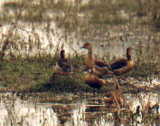
- Greylag Goose Anser anser
Up to 80 daily at Keoladeo Ghana
- Bar-headed Goose Anser indicus
Daily at Keoladeo Ghana with a max of 120 on 25/2
- Ruddy Shelduck Tadorna ferruginea
Seen on three occasions at Keoladeo Ghana, including 40 on 24/2
- Comb Duck Sarkidiornis melanotos
Up to four at Keoladeo Ghana
- Cotton Pygmy-Goose Nettapus coromandelianus
Two at Ranthambhor on 21/2 and up to four at Keoladeo Ghana
- Gadwall Anas strepera
Common at Keoladeo Ghana, including at least 500 on 27/2
- Eurasian Wigeon Anas penelope
Daily at Keoladeo Ghana with a max of 200 on 27/2
- Spot-billed Duck Anas poecilorhyncha
Small numbers (up to 15) daily at Keoladeo Ghana
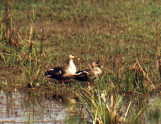
- Northern Shoveler Anas clypeata
Very common at Keoladeo Ghana: at least 2000 on 27/2
- Northern Pintail Anas acuta
Common at Keoladeo Ghana with at least 600 on 25/2
- Garganey Anas querquedula
Up to 12 at Keoladeo Ghana
- Common Teal Anas crecca
25 at Ranthambhor on 21/2 and common (at least 400 on 25/2) at Keoladeo
Ghana
- Red-crested Pochard Netta rufina
Two seen on a river between Ranthambhor and Keoladeo Ghana on 23/2 was
the only sighting
- Common Pochard Aythya ferina
Seen on three occasions at Keoladeo Ghana, including 120 on 25/2
- Ferruginous Duck Aythya nyroca
Small numbers (up to 20) daily at Keoladeo Ghana
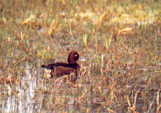
- Tufted Duck Aythya fuligula
A single bird at Keoladeo Ghana on 25/2
- Barred Buttonquail Turnix suscitator
One seen briefly at Ranthambhor on 21/2 and three flushed there the following
day
- Eurasian Wryneck Jynx torquilla
Two at Keoladeo Ghana on 26/2
- Brown-capped Pygmy Woodpecker Dendrocopos
nanus
Two at Keoladeo Ghana on 25/2
- Yellow-crowned Woodpecker Dendrocopos
mahrattensis
Fairly common, with two at Ranthambhor and up to three at Keoladeo Ghana
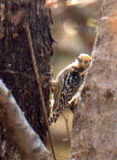
- Black-rumped Flameback Dinopium
benghalense
Common at both Ranthambhor and Keoladeo Ghana (where four were seen on
25/2) with one also at Lucknow on 2/3
- Brown-headed Barbet Megalaima
zeylanica
One at Lucknow on 4/3 was the only sighting
- Coppersmith Barbet Megalaima haemacephala
Seen or heard daily at Ranthambhor and one at Orchha on 2/3
- Indian Grey Hornbill Ocyceros
birostris
A single bird seen in flight near the Forest Nursery at Keoladeo Ghana
on 26/2
- Eurasian Hoopoe Upupa epops
Common throughout, with eight at Keoladeo Ghana on both 25/2 and 26/2
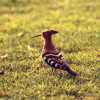
- Indian Roller Coracias benghalensis
Common
- Common Kingfisher Alcedo atthis
One at Ranthambhor on 21/2, daily sightings at Keoladeo Ghana with a max
of eight on 24/2
- White-breasted Kingfisher Halcyon
smyrnensis
Common throughout, with 15 at Keoladeo Ghana on 24/2
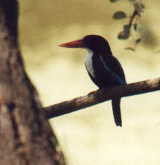
- Pied Kingfisher Ceryle rudis
Daily sightings of up to seven at Keoladeo Ghana and singles on three
occasions at Lucknow
- Green Bee-eater Merops orientalis
Common throughout, including 150 at Keoladeo Ghana on 25/2
- Common Hawk Cuckoo Cuculus varius
One at Keoladeo Ghana on 26/2, then one or two daily at Lucknow
- Sirkeer Malkoha Phaenicophaeus
leschenaultii
One at Keoladeo Ghana on 26/2 and one at Lucknow on 4/3
- Greater Coucal Centropus sinensis
One at Ranthambhor, then daily at Keoladeo Ghana (with 12 on 25/2) and
a few singles elsewhere
- Rose-ringed Parakeet Psittacula
krameri
Very common throughout, with at least 500 at Lucknow the highest daily
count
- Plum-headed Parakeet Psittacula
cyanocephala
A few daily at Ranthambhor, thereafter one at Orchha on 2/3
- Asian Palm Swift Cypsiurus balasiensis
Only seen at Lucknow where there were eight on 4/3
- Little Swift Apus affinis
Common throughout, the max day total being 500 on 28/2
- Collared Scops Owl Otus bakkamoena
One at Ranthambhor on 22/2, two more the following day and one at Keoladeo
Ghana on 25/2
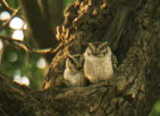
- Eurasian Eagle Owl Bubo bubo
One at dusk outside the entrance gate to Ranthambhor Park on 21/2
- Dusky Eagle Owl Bubo coromandus
Two seen and heard at dusk at Keoladeo Ghana on 24/2, and heard on two
other occasions
- Spotted Owlet Athene brama
Ones or twos at Ranthambhor, Keoladeo Ghana and Orchha
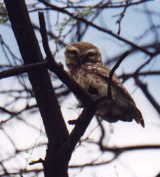
- Large-tailed Nightjar Caprimulgus
macrurus
One seen roosting during daylight in the Forest Nursery at Keoladeo Ghana
on 26/2 and 27/2
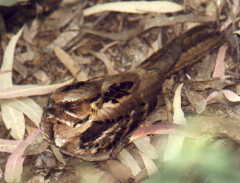
- Rock Pigeon Columba livia
Common
- Laughing Dove Streptopelia senegalensis
Common, 80 at Ranthambhor being the maximum recorded
- Spotted Dove Streptopelia chinensis
Fairly common in small numbers, although none recorded at Keoladeo Ghana
- Red Collared Dove Streptopelia
tranquebarica
One at Ranthambhor, two at Keoladeo Ghana and up to two at Lucknow
- Eurasian Collared Dove Streptopelia
decaocto
Common throughout
- Yellow-footed Green Pigeon Treron
phoenicoptera
Two at Ranthambhor on 21/2 and one the following day
- Siberian Crane Grus leucogeranus
The two wintering adults at Keoladeo Ghana were seen on 24/2 but were
thought to have departed by 26/2
- Sarus Crane Grus antigone
Four or five daily at Keoladeo Ghana were probably the same family party
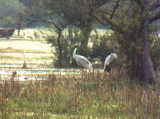
- Common Crane Grus grus
Seen on two occasions at Keoladeo Ghana, with 48 on 25/2
- Brown Crake Amaurornis akool
One seen in the canal at Keoladeo Ghana on 26/2 and 27/2
- White-breasted Waterhen Amaurornis
phoenicurus
Quite common at Keoladeo Ghana, with one also at Lucknow
- Purple Gallinule Porphyrio porphyrio
Very common (maximum of at least 1000) daily at Keoladeo Ghana
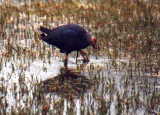
- Common Moorhen Gallinula chloropus
Common at Keoladeo Ghana
- Common Coot Fulica atra
Very common at Keoladeo Ghana with about 5000 estimated on 26/2
- Chestnut-bellied Sandgrouse Pterocles
exustus
32 seen in the semi-desert area of Ranthambhor on 22/2
- Painted Sandgrouse Pterocles indicus
Four seen in the semi-desert area of Ranthambhor on 22/2
- Common Snipe Gallinago gallinago
Up to four at Keoladeo Ghana
- Black-tailed Godwit Limosa limosa
One at Ranthambhor on 21/2 and up to ten at Keoladeo Ghana
- Spotted Redshank Tringa erythropus
One at Ranthambhor on 21/2 and up to eight at Keoladeo Ghana
- Common Redshank Tringa totanus
Up to five at Keoladeo Ghana
- Marsh Sandpiper Tringa stagnatilis
Two seen between Ranthambhor and Keoladeo Ghana on 23/2, then up to four
at Keoladeo Ghana
- Common Greenshank Tringa nebularia
Small numbers (up to four) at Keoladeo Ghana
- Green Sandpiper Tringa ochropus
Fairly common in small numbers, including 20 at Keoladeo Ghana on 25/2
- Wood Sandpiper Tringa glareola
Common at Keoladeo Ghana, with 120 there on 24/2
- Common Sandpiper Tringa hypoleucos
One or two at Ranthambhor, and two between Ranthambhor and Keoladeo Ghana
on 23/2
- Temminck's Stint Calidris temminckii
Two seen at Keoladeo Ghana on 24/2
- Ruff Philomachus pugnax
Very common at Keoladeo Ghana with at least 300 on 23/2
- Pheasant-tailed Jacana Hydrophasianus
chirurgus
One at Ranthambhor on 21/2, up to 30 at Keoladeo Ghana and five at Lucknow
on 5/3
- Bronze-winged Jacana Metopidius
indicus
Two at Ranthambhor on 21/2, up to 10 at Keoladeo Ghana
- Eurasian Thick-knee Burhinus oedicnemus
Three at Keoladeo Ghana on 25/2
- Black-winged Stilt Himantopus
himantopus
Common throughout, with 40 on 28/2 the maximum daily total
- Little Ringed Plover Charadrius
dubius
Up to two at Keoladeo Ghana
- Yellow-wattled Lapwing Vanellus
malarbaricus
Ten in the semi-desert area of Ranthambhor on 22/2
- Red-wattled Lapwing Vanellus indicus
Common throughout
- White-tailed Lapwing Vanellus
leucurus
Quite common at Keoladeo Ghana: daily sightings of up to 25
- Indian Courser Cursorius coromandelicus
Two seen in the semi-desert area of Ranthambhor on 22/2
- Yellow-legged Gull Larus cachinnans
One immature seen in flight at Keoladeo Ghana on 27/2
- River Tern Sterna aurantia
Up to two at Keoladeo Ghana
- Whiskered Tern Chlidonias hybridus
One at Keoladeo Ghana on 26/2
- Oriental Honey-buzzard Pernis
ptilorhyncus
One or two most days at Keoladeo Ghana
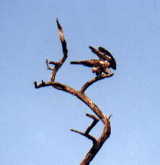
- Black-winged Kite Elanus caeruleus
Singles at Delhi Airport and Ranthambhor, and two at Lucknow on 5/3
- Black Kite Milvus migrans
Not seen at Ranthambhor and just one at Keoladeo Ghana, but several around
Agra and Lucknow
- White-tailed Eagle Haliaeetus
albicilla
One sub-adult at Keoladeo Ghana on 24/2
- Egyptian Vulture Neophron percnopterus
Common in small numbers
- White-rumped Vulture Gyps bengalensis
Common with up to 40 at both Ranthambhor and Keoladeo Ghana
- Long-billed Vulture Gyps indicus
Common with up to 60 at Ranthambhor, 20 at Keoladeo Ghana and 50 at Orchha
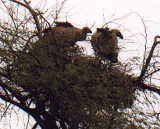
- Red-headed Vulture Sarcogyps calvus
One at Keoladeo Ghana on 25/2 and two the following day
- Short-toed Eagle Circaetus gallicus
One at Ranthambhor on 22/2
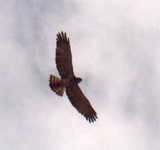
- Crested Serpent Eagle Spilornis
cheela
One between Ranthambhor and Keoladeo Ghana on 23/2 and up to two at Keoladeo
Ghana
- Eurasian Marsh Harrier Circus
aeruginosus
Two on several occasions at Keoladeo Ghana
- Montagu's/Pallid Harrier Circus
pygargus
One ringtail at Keoladeo Ghana on 25/2 was most likely a first-winter
Montagu's
- Shikra Accipiter badius
Widespread and relatively common with a max of four at Ranthambhor on
21/2
- Eurasian Sparrowhawk Accipiter
nisus
Singles on two dates at Keoladeo Ghana and one near Lucknow on 6/3
- Spotted Eagle Aquila clanga
The commonest aquila eagle. Up to five were seen at Keoladeo Ghana and
one at Ranthambhor
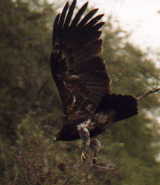
- Steppe Eagle Aquila nipalensis
One at Keoladeo Ghana on 25/2 and two on 27/2
- Imperial Eagle Aquila heliaca
A first-winter and a sub-adult at Keoladeo Ghana on two dates
- Bonelli's Eagle Hieraaetus fasciatus
Juveniles seen on two occasions at Keoladeo Ghana
- Booted Eagle Hieraaetus pennatus
Up to two dark phase birds at Keoladeo Ghana
- Common Kestrel Falco tinnunculus
One at Keoladeo Ghana and singles at a few other locations
- Little Grebe Tachybaptus ruficollis
Fairly common. Five at Ranthambhor, up to 12 daily at Keoladeo Ghana and
six at Lucknow
- Oriental Darter Anhinga melanogaster
Common (up to 50) at Keoladeo Ghana

- Little Cormorant Phalacrocorax
niger
Common throughout, including up to 100 at Ranthambhor and 150 at Keoladeo
Ghana
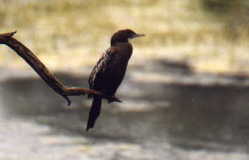
- Indian Cormorant Phalacrocorax
fuscicollis
Only seen at Keoladeo Ghana where there were about 30 on 27/2
- Great Cormorant Phalacrocorax
carbo
Common (up to 50 sinensis type) at Keoladeo Ghana
- Little Egret Egretta garzetta
Common at Keoladeo Ghana (up to 100) and a few seen at various other localities
- Grey Heron Ardea cinerea
Up to 150 at Keoladeo Ghana
- Purple Heron Ardea purpurea
Common at Keoladeo Ghana with up to 50 there, and one at Lucknow on 5/3
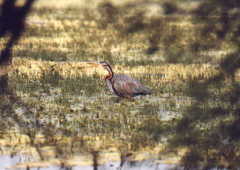
- Great Egret Casmerodius albus
Fairly common, particularly at Keoladeo Ghana where there were daily sightings
of up to 50
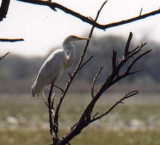
- Intermediate Egret Mesophoyx intermedia
Very common at Keoladeo Ghana with at least 400 on 27/2 and several seen
elsewhere, including 100 at Lucknow on 5/3
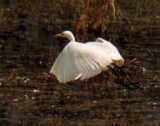
- Cattle Egret Bubulcus ibis
Fairly common and widespread, although just one at Keoladeo Ghana
- Indian Pond Heron Ardeola grayii
Common and widespread
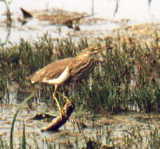
- Striated Heron Butorides striatus
One or two seen at Keoladeo Ghana
- Black-crowned Night Heron Nycticorax
nycticorax
Up to 80 at Keoladeo Ghana, mostly in a roost near Keoladeo Temple
- Yellow Bittern Ixobrychus sinensis
A single in the ditch beside the main track at Keoladeo Ghana on 24/2
- Glossy Ibis Plegadis falcinellus
Common at Keoladeo Ghana with up to 200
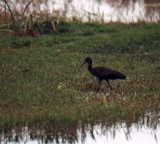
- Black-headed Ibis Threskiornis
melanocephalus
One at Ranthambhor on 21/2 and daily sightings (max of 80) at Keoladeo
Ghana
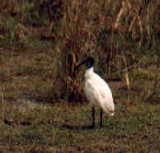
- Eurasian Spoonbill Platalea leucorodia
Common (up to 200) at Keoladeo Ghana
- Great White Pelican Pelecanus
onocrotalus
12 at Keoladeo Ghana on 24/2 and five there on 27/2
- Dalmatian Pelican Pelecanus crispus
Five at Keoladeo Ghana on 24/2 and one on 26/2
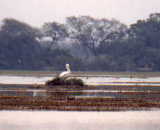
- Painted Stork Mycteria leucocephala
Very common at Keoladeo Ghana with at least 1000 at their nest colony;
small numbers seen elsewhere
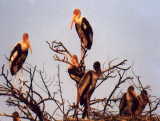
- Black Stork Ciconia nigra
Two in flight over Ranthambhor on 21/2
- Asian Openbill Anastomus oscitans
Small numbers (up to ten) daily at Keoladeo Ghana
- Woolly-necked Stork Ciconia episcopus
One or two seen most days at Keoladeo Ghana
- Black-necked Stork Ephippiorhynchus
asiaticus
Up to three daily at Keoladeo Ghana
- Lesser Adjutant Leptoptilos javanicus
One at Keoladeo Ghana was seen on 25/2 at Mrig Tal
- Rufous-tailed Shrike Lanius isabellinus
Singles at Keoladeo Ghana on 25/2 and 26/2
- Bay-backed Shrike Lanius vittatus
Up to three at Ranthambhor, two between Ranthambhor and Keoladeo Ghana
and singles on two occasions at Keoladeo Ghana
- Long-tailed Shrike Lanius schach
A few seen at various sites, including five at Ranthambhor
- Southern Grey Shrike Lanius meridonialis
Up to five at Ranthambhor and 15 seen between there and Keoladeo Ghana
on 23/2

- Rufous Treepie Dendrocitta vagabunda
Common and widespread, the max being 25 at Ranthambhor on 21/2
- House Crow Corvus splendens
Common
- Jungle Crow Corvus levaillantii
Small numbers seen regularly
- Large Cuckooshrike Coracina macei
Six at Ranthambhor on 21/2
- Small Minivet Pericrocotus cinnamomeus
Small numbers at both Ranthambhor and Keoladeo Ghana
- White-browed Fantail Rhipidura
aureola
Three at Ranthambhor and two at Keoladeo Ghana
- Black Drongo Dicrurus macrocercus
Common throughout
- Ashy Drongo Dicrurus leucophaeus
Two at Keoladeo Ghana in the Forest Nursery on 27/2
- White-bellied Drongo Dicrurus
caerulescens
Six seen at Ranthambhor on 21/2 and two there the following day
- Common Iora Aegithina tiphia
Two at Ranthambhor on 21/2 were the only sighting
- Common Woodshrike Tephrodornis
pondicerianus
A few observed at several sites
- Blue Rock Thrush Monticola solitarius
One seen in the village at the semi-desert area of Ranthambhor on 22/2
- Tickell's Thrush Turdus unicolor
One near the entrance gate of Ranthambhor on 21/2 and up to two seen at
Keoladeo Ghana on three (always brief) occasions
- Red-breasted Flycatcher Ficedula
parva
Fairly common, the maximum observed being seven at Ranthambhor on 21/2
and eight at Keoladeo Ghana on 26/2
- Tickell's Blue Flycatcher Cyornis
tickelliae
One near the entrance gate of Ranthambhor on 21/2
- Grey-headed Canary Flycatcher Culicicapa
ceylonensis
Six at Ranthambhor on 21/2 and up to four at Keoladeo Ghana
- Bluethroat Luscinia svecica
Two daily at Keoladeo Ghana and three at Lucknow on 5/3
- Oriental Magpie Robin Copsychus
saularis
Common and widespread
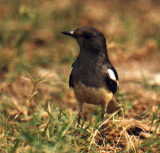
- White-rumped Shama Copsychus malabaricus
One at Ranthambhor on 21/2
- Indian Robin Saxicoloides fulicata
Common, 25 at Ranthambhor on 22/2 being the maximum noted
- Black Redstart Phoenicurus ochruros
Up to three at various sites
- Common Stonechat Saxicola torquata
Two at Ranthambhor on 22/2 and two at Lucknow on 4/3
- Pied Bushchat Saxicola caprata
Seen at several sites including 40 at Keoladeo Ghana on 25/2
- Indian Chat Cercomela fusca
Seen at Ranthambhor, Fatehpur Sikri, Jhansi Fort, and up to 15 at Orchha
- Brahminy Starling Sturnus pagodarum
Fairly common, peaks being 60 at Ranthambhor and 50 at Keoladeo Ghana
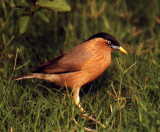
- Common Starling Sturnus vulgaris
One at Lucknow on 5/3
- Asian Pied Starling Sturnus contra
Two at Ranthambhor on 21/2 and then several at Keoladeo Ghana and a few
around Lucknow
- Common Myna Acridotheres tristis
Very common and widespread
- Bank Myna Acridotheres ginginianus
Up to 12 at Ranthambhor and just one at Keoladeo Ghana, thereafter several
further north and very common around Agra
- Great Tit Parus major
Up to eight at Ranthambhor
- Sand Martin Riparia riparia
Two at Keoladeo Ghana on 27/2
- Plain Martin Riparia paludicola
Eight at Ranthambhor and up to six at Keoladeo Ghana
- Dusky Crag Martin Hirundo concolor
40 at Ranthambhor, two at Jhansi and up to 20 at Orchha
- Barn Swallow Hirundo rustica
Very common at Keoladeo Ghana, few elsewhere
- Wire-tailed Swallow Hirundo smithii
Two at Keoladeo Ghana on two occasions
- Red-rumped Swallow Hirundo daurica
Two at Lucknow on 4/3
- Red-whiskered Bulbul Pycnonotus
jocosus
Up to four at Lucknow
- White-eared Bulbul Pycnonotus
leucotis
Up to ten seen daily at Keoladeo Ghana
- Red-vented Bulbul Pycnonotus cafer
Common and widespread
- Zitting Cisticola Cisticola juncidis
Up to 15 at Lucknow
- Rufous-fronted Prinia Prinia buchanani
Two singing birds in the semi-desert area of Ranthambhor on 22/2
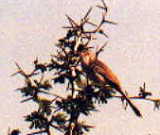
- Graceful Prinia Prinia gracilis
One at Keoladeo Ghana and two at Lucknow
- Jungle Prinia Prinia sylvatica
Up to 15 at Ranthambhor
- Ashy Prinia Prinia socialis
Three at Ranthambhor on 21/2
- Plain Prinia Prinia inornata
Two at Ranthambhor, Keoladeo Ghana and Orchha, and ten at Lucknow
- Oriental White-eye Zosterops palpebrosus
One near Lucknow on 6/3
- Blyth's Reed Warbler Acrocephalus
dumetorum
Seen daily (up to eight) at Keoladeo Ghana and one near Lucknow on 6/3
- Clamorous Reed Warbler Acrocephalus
stentoreus
Up to six at Keoladeo Ghana
- Common Tailorbird Orthotomus sutorius
Small numbers seen throughout
- Common Chiffchaff Phylloscopus
collybita
One at Ranthambhor, up to 30 at Keoladeo Ghana and two at Lucknow on 4/3
- Dusky Warbler Phylloscopus fuscatus
Three at Keoladeo Ghana on 24/2 and one there on 26/2
- Hume's Warbler Syrmaticus humiae
Fairly common with up to eight at Ranthambhor, 25 at Keoladeo Ghana and
singles elsewhere
- Greenish Warbler Phylloscopus
trochiloides
Four at Ranthambhor on 21/2 and singles at Keoladeo Ghana
- Common Babbler Turdoides caudatus
Seven at Ranthambhor on 22/2, then singles at Keoladeo Ghana and Orchha
- Large Grey Babbler Turdoides malcolmi
Seen at Ranthambhor (up to eight) and in the dry areas of Keoladeo Ghana
where there were 50 on 26/2
- Jungle Babbler Turdoides striatus
Common and widespread
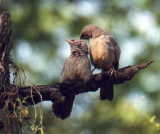
- Lesser Whitethroat Sylvia curruca
One at Ranthambhor, up to 50 at Keoladeo Ghana and one at Lucknow
- Indian Lark Mirafra erythroptera
Up to five at Ranthambhor, near the road from Sawai Madhopur and in the
semi-desert area nearby
- Ashy-crowned Sparrow-Lark Eremopterix
grisea
80 in the semi-desert area of Ranthambhor on 22/2, four at the southernmost
point of Keoladeo Ghana, and a few at Lucknow
- Rufous-tailed Lark Ammomanes phoenicurus
Two at Lala Pyare Ka Kund, Keoladeo Ghana on 25/2
- Greater Short-toed Lark Calandrella
brachydactyla
Four in the semi-desert area of Ranthambhor on 22/2
- Crested Lark Galerida cristata
Two at Koladahar, Keoladeo Ghana on 26/2
- Oriental Skylark Alauda gulgula
Two at Koladahar, Keoladeo Ghana on 26/2 and up to 20 at Lucknow
- Purple Sunbird Nectarinia asiatica
Small numbers seen at various localities
- House Sparrow Passer domesticus
Common
- Chestnut-shouldered Petronia Petronia
xanthocollis
Seen at various sites including 50 at Keoladeo Ghana and 40 at Lucknow
- White Wagtail Motacilla alba
Singles at a few sites
- White-browed Wagtail Motacilla
madaraspatensis
Up to two seen at Keoladeo Ghana
- Citrine Wagtail Motacilla citreola
Common with up to 100 seen daily at Keoladeo Ghana
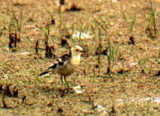
- Yellow Wagtail Motacilla flava
Four at Lucknow on 4/3 were the only sighting
- Grey Wagtail Motacilla cinerea
Up to four at Ranthambhor, one at Keoladeo Ghana and two at Orchha
- Paddyfield Pipit Anthus rufulus
Common (at least 70) in the semi-desert area of Ranthambhor on 22/2. Also
four at Keoladeo Ghana on 25/2 and up to 10 at Lucknow
- Tawny Pipit Anthus campestris
One was seen in the Ranthambhor semi-desert area on 22/2
- Blyth's Pipit Anthus godlewskii
About 10 were seen with other pipits in the semi-desert area of Ranthambhor
on 22/2
- Tree Pipit Anthus trivialis
100 were seen in alfalfa fields at Lucknow on 5/3
- Olive-backed Pipit Anthus hodgsoni
Fairly common in small numbers at Ranthambhor, Keoladeo Ghana and Lucknow,
where the maximum count of 10 was recorded
- Rosy Pipit Anthus roseatus
One at Lucknow on 5/3
- Streaked Weaver Ploceus manyar
At least four seen near Python Point, Keoladeo Ghana on 27/2
- White-throated Munia Lonchura
malabarica
Single sightings at each of Ranthambhor, Keoladeo Ghana, Orchha and Lucknow
Other Bird Notes
- [Lesser Spotted Eagle Aquila (pomarina)
hastata]
Although at the time I believed that I had definite sightings of Lesser
Spotted Eagle with one at Keoladeo Ghana on 25/2 and two there on 27/2, I
now no longer consider the identification of these to be confirmed and hence
remove these records. This follows the split of Indian Spotted Eagle A.
hastata from Lesser Spotted Eagle A. pomarina and the realisation
that it is more similar to Greater Spotted A. clanga than Lesser Spotted.
- [White-capped Bunting Emberiza
stewarti]
A bunting, probably of this species, was seen twice in flight at Ranthambhor
Fort on 21/2
- Wild Boar Sus
scrofa
Seen at Ranthambhor both days and on one occasion at
Keoladeo Ghana
- Five-striped Palm
Squirrel Funambulus pennantii
Very common throughout
- Rhesus Macaque Macaca
mulatta
Common at Keoladeo Ghana and seen elsewhere in the north
- Sambar Cervus
unicolor
Fairly common at Ranthambhor and Keoladeo Ghana
- Nilgai (Blue Bull) Boselaphus
tragocamelus
Fairly common at Ranthambhor and Keoladeo Ghana
- Golden Jackal Canis
aureus
Common at Keoladeo Ghana
- Chinkara (Indian Gazelle)
Gazella bennettii
Two just south of the Sawai Madhopur road near
Ranthambhor on 21/2 and two in Ranthambhor Park on 22/2
- Chital (Spotted Deer) Axis
axis
Common at Ranthambhor; fairly common at Keoladeo Ghana
- Common Langur Semnopithecus
entellus
Very common at Ranthambhor
- Indian Grey (Common
Indian) Mongoose Herpestes edwardsii
Three seen at Keoladeo Ghana, one at Orchha
- Ruddy Mongoose Herpestes
smithii
One at Ranthambhor on 23/2 and one seen beside the road
from Nepalgunj to Lucknow on 7/3
- Sloth Bear Ursus
ursinus
One at Ranthambhor from the gypsy in the late afternoon
of 22/2 gave superb close views as it walked along a
stone wall before moving off into the vegetation
- Marsh Mugger
Two seen at the lake at Ranthambhor on 21/2
- Indian Rock Python
One in a tree near Keoladeo Temple on 24/2
Other Wildlife Notes
- [Leopard Panthera
pardus]
One large mammal seen briefly at Ranthambhor from the
gypsy on the morning of 23/2 was almost certainly a
Leopard, although couldn't be seen when we drove closer.
Had we waited where we first caught a glimpse of it we
undoubtedly would have seen it move out of its relatively
flimsy cover, but the Indian guide insisted on taking the
gypsy at breakneck speed until we were within ten metres
of where it had been. Not surprisingly, although there
was lots of commotion amongst the Common Langurs nearby,
the Leopard was nowhere to be seen!
- [Tiger Panthera
tigris]
Although not seen personally, tigers were generally seen
daily by at least one of the gypsies at Ranthambhor. At
the entrance gate at dusk on 21/2 I met a BBC film crew,
including Michaela Strachan, who had been successfully
filming tigers for The Really Wild Show. I showed them an
Eagle Owl through my scope, but unfortunately was not
repaid with any tiger sightings! On 22/2, when I took a
gypsy trip into the Park, one was seen from the canter
along the entrance road, an area where I had been walking
alone at a similar time the day before!
- [Turtle sp]
At least two different species were seen at Keoladeo
Ghana. One small species was seen daily and a larger,
smooth-shelled, turtle was seen on 27/2.
|

















